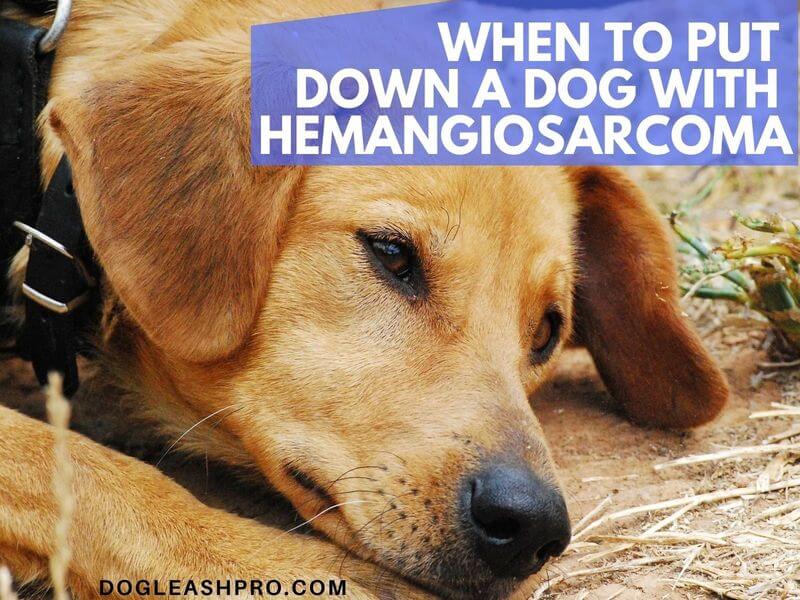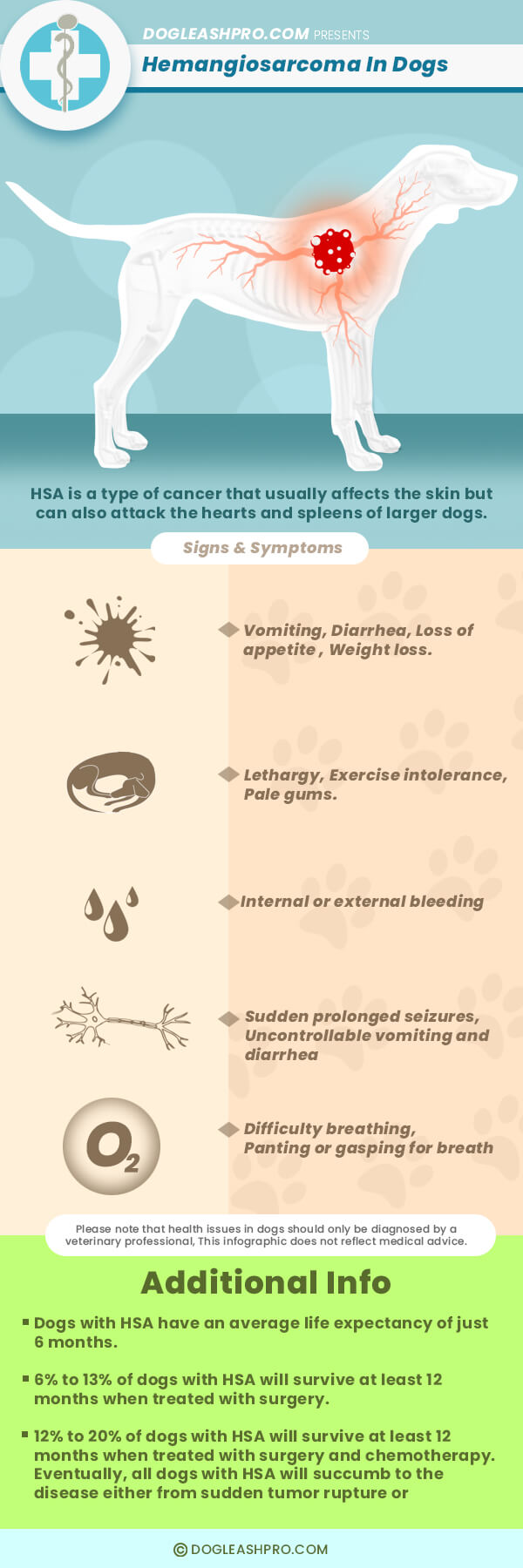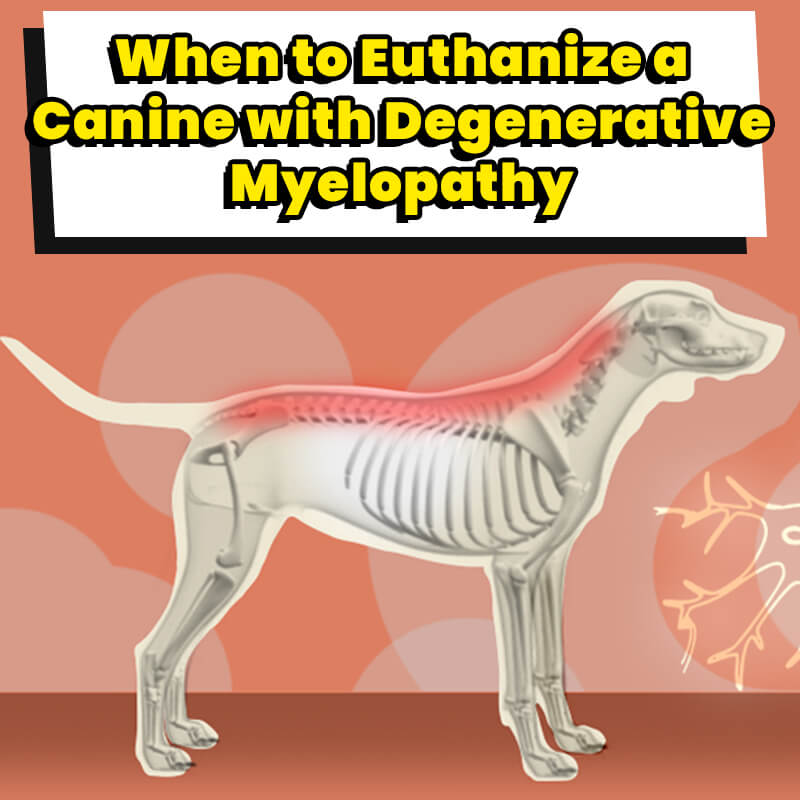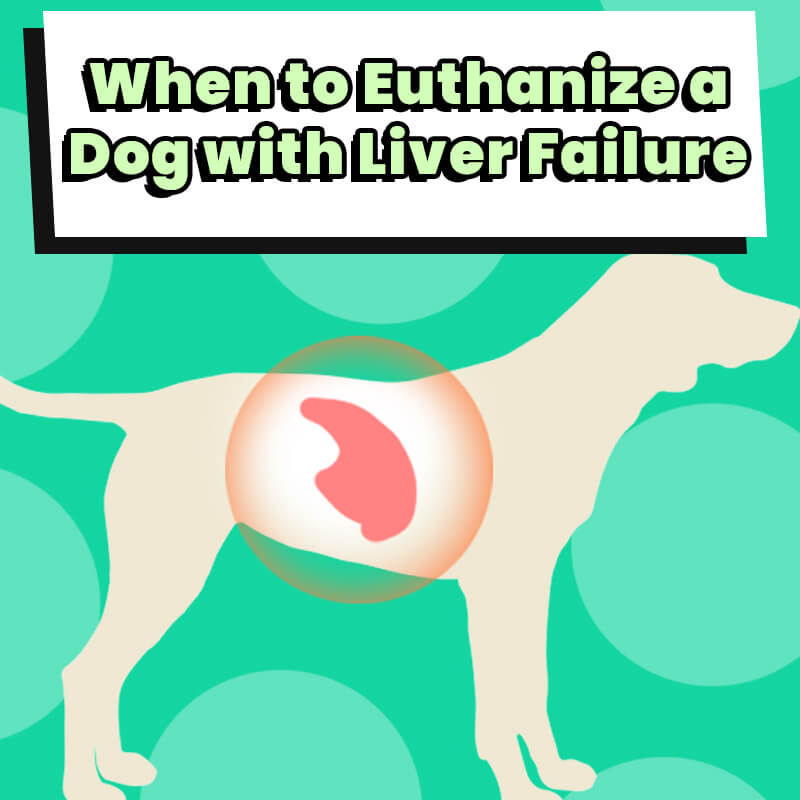
Hemangiosarcoma is a cancer that often appears without warning signs. In many cases, diagnosis occurs after a haemorrhage or a ruptured tumor. When this happens, it may be too late for treatment. Owners may not have enough time to make a decision on euthanasia or know when is the right time to put their dog down.
When to euthanize a dog with hemangiosarcoma? If hemangiosarcoma appears suddenly and your dog is suffering from massive blood loss, you may be forced to discuss with your vet if now is the time to euthanize your dog. Depending on the type of HSA, available treatment options, and stage of cancer, your vet will help advise when to put down a dog.
Some owners may be luckier and have a little more time to decide. Be aware that some of the dog breeds most commonly affected by hemangiosarcoma are also predisposed to lymphoma so make sure to read our blog on dog lymphoma: when to euthanize to rule out other possible conditions.
Table of Contents
What is hemangiosarcoma?
Hemangiosarcoma in dogs or HSA is a common and fatal cancer that strikes at any time without warning. It’s an aggressive cancer of the blood vessel walls. Cancerous cells grow uncontrollably and line the blood vessels.
When blood travels throughout the dog’s body, the cancerous cells spread to multiple organs including the heart, liver, and spleen. These three organs require an abundant supply of blood so they become common sites where the tumor is found.
Without warning, the blood-filled tumor can rupture at any time. This leads to internal and external bleeding resulting in massive blood loss. Both the owner and the vet are forced to make difficult decisions within minutes of diagnosis on whether to euthanize the dog or extend its life through treatments.
HSA is highly metastatic and will spread to the lungs, brain, kidneys, bones, and skeletal muscle. Unfortunately, there is currently no cure for this cancer.
Facts about hemangiosarcoma
Here are some quick facts about hemangiosarcoma:
- It accounts for 0.2 to 3 percent of all canine tumors.
- The mean age at diagnosis is 9 to 12 years of age.
- It commonly affects the heart and spleen of larger dog breeds.
- HSA usually affects the skin.
- In many cases, owners are not aware their dog has HSA until the ruptured tumor tissue causes catastrophic hemorrhage.
Helping you decide when to euthanize your dog with hemangiosarcoma
Canine hemangiosarcoma is fatal for two reasons. One, you may not know your dog is suffering from the disease until it’s at an advanced stage. Second, classic cancer treatments and surgeries often do not help.
Upon official diagnosis from your vet, these two reasons may force the owner to decide whether to put down their dog with hemangiosarcoma. Fortunately, depending on the type of hemangiosarcoma and the prognosis, this may not always be the case.
The steps below will help you decide when to put down your dog if they have hemangiosarcoma.

Total Time Needed :
30
Minutes
Total Cost:
50
USD to 300+ USD
Required Tools:
Things Needed?
Steps to decide if you should euthanize your dog with hemangiosarcoma

Hemangiosarcoma in dogs diagnosis
Visit your vet right away if you suspect your dog may have HSA. Your vet will perform a thorough physical exam, a complete blood cell count, urinalysis, coagulation profile, and biochemistry profile.
There may be diagnostic imaging such as ultrasound or radiographs. They help to detect where the masses are. The vet may use a fine needle aspirate to take a fluid or tissue biopsy in order to find out what type of tumor it is.
After these tests, your vet should provide you with a proper diagnosis.
What causes hemangiosarcoma in dogs?
The exact reasons for canine hemangiosarcoma are still unknown. Researchers suggest that constant exposure to carcinogens may cause this disease. Carcinogens such as chlorides, chemicals, tobacco smoke, and asbestos are substances that are capable of causing cancer.
What we do know is that some dog breeds have a genetic predisposition to the disease and are more at risk of developing hemangiosarcoma.
According to the Morris Animal Foundation, larger dog breeds are most likely to get HSA. They include:
- German Shepherd Dogs
- Golden Retrievers
- Labrador Retrievers
- Portuguese Water Dogs
- Basset Hounds
- Boxers
- Bernese Mountain Dogs
- Dalmatians
- Dobermans
- English Setters
- Flat-Coated Retrievers
- Great Danes
- Poodles
- Pit Bull Terriers
- Skye Terriers
- Whippets
While these dog breeds are more prone to HSA, it can also affect a lot of dogs. HSA can occur in middle to older-aged dogs, specifically those aged 6 years and older. Some studies suggest that slightly more males get HSA than females.
Canine hemangiosarcoma stages
While there are no clinical signs that are specifically associated with canine hemangiosarcoma other than sudden internal bleeding, we’ve listed the following hemangiosarcoma dog symptoms often reported by owners at each stage.
Call your vet right away if you notice any behavioral or health changes. Early detection is key.
Early Stage
In the early stage, the symptoms are as follows:
- Diarrhea
- Distended abdomen
- Dramatic increase in respiratory rate
- Exercise intolerance
- Lethargy
- Loss of appetite
- Pale gums
- Vomiting
- Weight loss
Mid Stage
In the mid-stage, there could be additional signs including:
- Abnormal Mentation
- Black tarry stool
- Difficulty breathing
- Panting or gasping for breath
- Reclusive behavior
- Sudden collapse
Late Stage
The late-stage is the crisis stage. During this advanced stage, your dog may feel pain from internal or external bleeding. Here are the following signs:
- Sudden prolonged seizures
- Uncontrollable vomiting and diarrhea
- Crying or whining due to pain
- Profuse internal or external bleeding
Please do not wait until the late stage to contact your vet. It may be too late and you won’t have enough time to make a decision on the next steps.
Can dogs survive hemangiosarcoma?
It’s crucial to know the survival rate of canine HSA before you decide when is it time to euthanize a dog with hemangiosarcoma. Depending on the type, your dog may or may not survive it.
There are four main types of canine hemangiosarcoma and the survival rate for each varies. Below is a general guideline but you should also speak with your vet for a professional opinion.
1. Dermal Hemangiosarcoma (on the skin)
Canine hemangiosarcoma on the skin has the highest chance for a potential cure. The prognosis can be quite good if the cancerous tissue is promptly removed through surgery.
Your dog can expect to live a little longer and the decision to euthanize can be put off for now.
How do you know if your dog has dermal Hemangiosarcoma? There may be red or even black growth on your dog’s skin. It is associated with sun exposure and tends to form on sparsely haired skin such as the abdomen or on areas with white fur.
Thus, dogs with short or white-haired fur are predisposed to developing dermal hemangiosarcoma.
2. Subcutaneous Hemangiosarcoma (under the skin)
Also known as hypedermal hemangiosarcoma, this type is more aggressive than dermal hemangiosarcoma. Under the skin, you’ll see a dark red blood growth.
In 60% of cases, it will spread internally. If it is internal, there is no chance of survival.
3. Visceral Hemangiosarcoma (internal organ – Spleen)
Also called the splenic hemangiosarcoma, it’s when the blood-filled tumor grows rapidly in the spleen and has a high tendency to break open and bleed profusely. It doesn’t matter if the condition is malignant or benign.
If the tumors break open in the spleen, it is life-threatening. There is no chance of survival, even with the help of surgical intervention or splenectomy.
About 25% of dogs with splenic hemangiosarcoma also have a heart-based hemangiosarcoma.
4. Visceral Hemangiosarcoma (internal organ – Heart)
Heart-based hemangiosarcoma is similar to splenic hemangiosarcoma in that it is also life-threatening.
The effect of internal bleeding is dangerous because the heart is surrounded by a sac called the pericardium. A sudden rupture causes the blood to fill up the sac and put a lot of pressure on the heart.
Even with surgical intervention, there is no chance of survival after a pericardial effusion.
How long can a dog live with hemangiosarcoma?
Sadly even with the help of chemotherapy and surgery, the survival time is one year or less. The tumor will continue to progress and spread throughout the dog’s body. Eventually, the tumor will create masses in multiple organs leading to massive bleeding from hemorrhages.
The Whole Dog Journal points out the following after a proper diagnosis:
- Dogs with HSA have an average life expectancy of just 6 months.
- 6% to 13% of dogs with HSA will survive at least 12 months when treated with surgery.
- 12% to 20% of dogs with HSA will survive at least 12 months when treated with surgery and chemotherapy.
- Eventually, all dogs with HSA will succumb to the disease either from sudden tumor rupture or metastasis to the organs.
These statistics are hard to swallow. At some point, you will need to make the difficult decision to euthanize your dog with hemangiosarcoma.
How long can a dog live with hemangiosarcoma without surgery?
The type of hemangiosarcoma will affect how long the dog can live without surgery. The Whole Dog Journal informs us that:
- If dogs have dermal HSA that cannot be treated, how long they can live varies.
- Untreated dogs with hypodermal HSA have 6 months to live.
- On average, untreated dogs with visceral HSA will die between 7 and 14 days post-diagnosis.
Hemangiosarcoma dog treatment
Explore all possible dog treatment options with your vet before making the decision to put down your dog. Depending on the type of HSA, your vet may provide you with a few treatment options.
For instance, dogs with skin hemangiosarcoma might have a fighting chance. If it hasn’t gotten under the skin to be in a hypodermal form, then it can be treated through surgery and chemotherapy.
However, if your dog has visceral hemangiosarcoma, you may not know until it is in the late stage. The signs usually remain undetected. Treatments such as surgery, chemotherapy, or radiotherapy may prove futile. Unfortunately, your pup will die from HSA or need to be put down.
Many owners have heard about natural remedies or holistic treatment for hemangiosarcoma in dogs. While you can try them in order to prevent putting down your dog with hemangiosarcoma, know that your vet may have better treatment options.
When it comes to holistic treatment for hemangiosarcoma, Canine Health Foundation explains it best.
If you’re not sure, consult with your vet for treatment options. Ask for their professional opinion on when to euthanize a dog with hemangiosarcoma.
Deciding if you should euthanize your dog with HSA
Making the decision to euthanize your dog with hemangiosarcoma can be tough. You may have thoughts and questions racing through your head while still shocked by what has happened.
Before euthanizing, it’s best to ask these questions first:
- How is your dog’s quality of life good?
- What is your dog’s mood? Is he happy, eating regularly, enjoying life, or is he miserable and sad?
- Is your pup in pain? If so, what treatments can the vet provide?
- Have you noticed your furry friend being incontinent?
If you find your dog suffering more than he is enjoying life, it may be best to think about putting him down. Regardless of what you think you should do, speak with your vet to get their advice on the matter.
Both you and your vet may decide that euthanasia is the most humane choice since it will save your dog from further suffering.
How does dog euthanasia work?
Once you’ve made your decision along with your vet, they will handle the entire procedure for you. If you have any questions, feel free to ask. If you have a large dog, your pup will be laid down on a table for the procedure. Smaller dogs will be held by a vet’s assistant.
Your vet will administer an anesthetic drug of sodium pentobarbital. It will quickly cause your dog to lose consciousness and painlessly stop the heart. The vet will then check for a heartbeat and confirm the time of passing. You’ll have a few moments with your dog.
Since this is the last time you will see your furry companion, mentally prepare yourself to say goodbye. Think back to any fond and happy memories you had together and know they are now free from pain.
With this decision, you made the humane decision to not see your canine family member suffer and have given them a painless and quick end to their suffering.
Ways to remember your dog
After the euthanization procedure, you may decide to have either a traditional burial (at a pet cemetery or in your yard if your town allows it) or a cremation.
Many pet owners choose to cremate their beloved furry companion in order to keep the remains in the house within an urn. Some also choose to customize the urn with quotes and favorite memories.
Pet Insurance
In many cases, euthanization may be the only option since hemangiosarcoma strikes hard and fast. Unfortunately, there is still no known cure for dogs with hemangiosarcoma.
If you’re going the treatment route but it’s too expensive, consider getting pet insurance. We advise owners to get pet insurance before they need it because it will help you pay for your dog’s treatment in case of an emergency. Having pet insurance will go a long way.
Don’t wait until your pet needs insurance to get it. Signing your pet up to be covered early can help keep monthly payments low and give you peace of mind.
Lasting thoughts
Deciding when to euthanize your dog is a tough decision to make. It is a humanitarian choice to end the suffering of your beloved dog. If you need help, ask your vet. They will help you come to a decision.
Be sure to gather all the facts before making a decision to euthanize.
Conclusion
At some point, many pet owners will have to face the decision of when is the right time to put down a dog. In most cases, owners will have time to think it through before making an informed decision.
With hemangiosarcoma, that may not be true since it can happen suddenly without warning.
The aggressive malignant nature of HSA will often force you to make a quick decision of whether to euthanize without enough time to consider options.
Always consult with your vet if you have any questions or concern.
I wish for peace and comfort for all of you and for your dogs.
Related Questions
It depends. In the early stages, hemangiosarcoma is a disease that does not really cause pain. In fact, the rate of growth during this stage is somewhat slow. There have been multiple cases where canines with large hemangiosarcomas did not show symptoms or clinical signs that they have this dangerous disease.
The blood vessels with tumor cells get twisted and become abnormally formed so when the blood cells flow in, they stay there and clot. Tumor cells need blood and nutrients to keep growing, but malformed vessels and clots prevent this from happening.
As a result, the tumor cells die and when it does happen, it ruptures the tumor and vessels and the blood escapes out into the chest, heart sac, abdomen, and subcutaneous space.
Dogs may suffer from weakness and lethargy depending on how much blood they lost. If you notice any of these signs, make sure to bring your pooch to the vet right away. The symptoms of this disease may seem subtle, which is why many owners may not think twice about it until this life-threatening disease has gone too far.
By the time some dog owners notice abnormal behavior, the hemangiosarcoma has metastasized to the mesentery, intestines, liver, and lungs. Consult with your vet because when a large tumor ruptures, it may lead to collapse, severe hemorrhage, and can be fatal.
DISCLAIMER: THIS WEBSITE DOES NOT PROVIDE MEDICAL ADVICE
The information, including but not limited to, text, graphics, images and other material contained on this website are for informational purposes only. No material on this site is intended to be a substitute for professional veterinary advice, diagnosis, or treatment. Always seek the advice of your veterinarian or other qualified health care provider with any questions you may have regarding a medical condition.

With over five years of specialized experience as an animal writer, my expertise lies in dog nutrition, health, behavior, grooming, and training. I am dedicated to delivering helpful and informative content that caters to the well-being of our furry friends. My primary goal is to empower pet owners with knowledge and ensure our canine companions thrive in health and happiness. In my free time, I love volunteering at local dog rescue centers.














